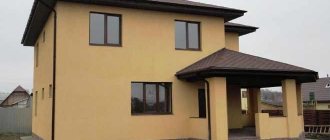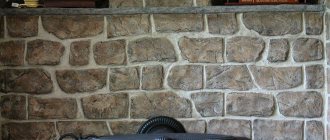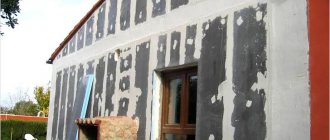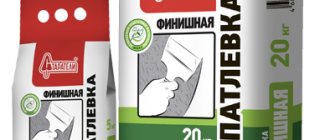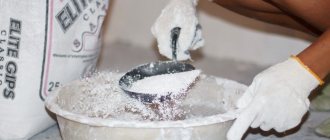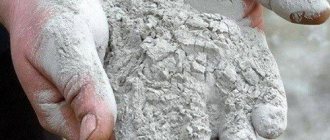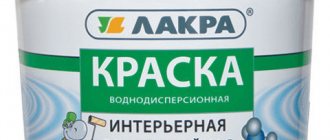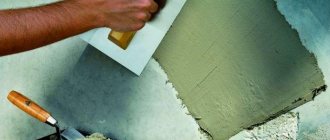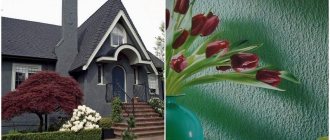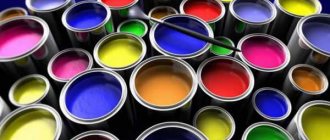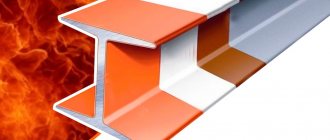8331 0 1
Vadim June 13, 2017
What façade putty for exterior use is currently on the market? Let's find out together what types of putty exist, what these or other compounds are used for, and what brands make a quality product. And for the DIYers, I’ll tell you how to putty the facade of a house for painting with your own hands in two ways.
Puttying the facade is one of the main stages of home improvement.
Types of mixtures
Putty for external use is classified according to its composition, purpose, and nature of application. The initial color of the mixture is white. Shade is given by adding pigments or tinting compounds, so decorativeness does not affect the choice.
By purpose
Finishing and starting putty differ in grain size.
Mixtures for external work are divided into starting, finishing and universal.
- Starting putty is a coarse-grained mixture with a high degree of adhesion. It serves as a base for finishing and fills in minor irregularities and chips. The starting mixture is applied in a layer 5–20 mm thick. Not suitable for sealing large cracks, but will hide small ones.
- Finish – fine-grained material, elastic and more liquid in consistency. Apply a thin layer of 3–6 mm, occasionally 10 mm. In the latter case, a reinforcing mesh is required. The task of finishing is to give the surface a visible evenness and smoothness. It is not suitable for sealing cracks, since the consumption increases sharply, and the cost of the finishing putty is high.
- Universal - a finely dispersed mixture or with a medium fraction, which, thanks to special modifying additives, retains the volumetric structure. Replaces both types of finishes. It fills chips, masks cracks, and creates a fairly even coating. It is inferior in density and strength to finishing putty.
Universal formulations are recommended for use in regions with mild climates.
By composition
Cement putty
The putty composition is standard: binder, filler and solvent - water. Ground quartz sand – marshalite, marble dust – is used as a filler.
The binder may vary. Putties are divided into cement and polymer.
Cement - based on high grade Portland cement - not lower than M400. Cement is one of the materials that hardens at the highest humidity. So the putty is not afraid of rain, snow, or sea water. The coating is durable, vapor-permeable, and easy to maintain. The price of the mixture is low. However, the composition shrinks when dried, so if the technology is violated, the coating becomes covered with cracks.
Polymer – based on polymers, most often latex and acrylic.
- Acrylic – based on acrylates or compounds including acrylates. It has a very high speed of complete drying - usually 2-3 hours, and does not shrink. The mixture is elastic and easy to apply in a thin layer. The strength is quite sufficient. However, acrylic putty can only be applied in a thin layer, so it does not level out defects more than 3 mm deep.
- Latex - available only in finished form. The mixture is plastic, easy to apply, and does not shrink. Latex putty is odorless, does not contain toxins and can be used for interior work. Waterproof and frost-resistant. Suitable for northern regions. The disadvantage is the high cost.
In no case should you use putties based on gypsum or chalk to finish facades.
Criterias of choice
The mixture is selected taking into account the following parameters:
- compatibility with wall paintwork;
- setting and hardening times;
- consumption per 1 m² - the smaller the grain of the filler, the thinner the layer can be applied;
- operating conditions – frequent rains, direct rays of sun, sea coast.
Preferable compositions that can be tinted. In this case, there is no need to paint the finish.
Criteria for choosing façade putties
The choice of one or another type of putty material for finishing facades will depend on several factors.
First, estimate the area of future work. Is it big or small? What atmospheric changes are most often observed, what natural factors affect the facade (sunny side, rain, direction, etc.). Having studied, at least approximately, these parameters, you can already judge whether it is possible to use putty with added color and how long it will serve you.
Secondly, evaluate the surface for existing defects and problems. If the wall needs serious alignment, then the appropriate type is selected.
Finally, based on the previous criteria, the last one is hidden. The approximate consumption of the mixture is calculated. Varieties of facade putty differ from each other in price categories, and if the area is large, then the choice of one type or another will depend on your financial capabilities.
Recommendations for use
Working with façade waterproof putty is easy. But there are some rules that need to be followed.
- The facade is prepared for finishing: cleaned of dirt, oil stains, and primed. Preference is given to antiseptic primers.
- The dry mixture is prepared according to the instructions.
- Use and prepare the solution in small portions, since the setting time of the putty is short - from 40 minutes to 2 hours.
- Before puttying, large defects are sealed with plaster.
- If the composition is applied in several layers, each previous layer is completely dried and primed.
Do not carry out work in extreme heat or during rain. This reduces the quality of the finish.
How much does it cost to plaster the facade of a house?
Our services
| Facade works | up to 1000 sq. m | more than 1000 sq. m |
| Plaster surface, 10 mm | 370 rub./sq. m | 300 rub./sq. m |
| Removing old plaster | 120 rub./sq. m | 80 rub./sq. m |
| Surface hydrophobization | 75 rub./sq. m | 60 rub./sq. m |
| Insulation of facade walls with expanded polystyrene or mineral wool | 380 rub./sq. m | 360 rub./sq. m |
Review of manufacturers
The rating of putty manufacturers includes domestic and foreign companies. The most famous include:
- Bergauf Glatte Zement is the best starting mixture. The composition is plastic, with increased resistance to cracking. Operates at temperatures from -50 to +70°C.
- “Rusean TT” is a façade finish with high vapor permeability, moisture-resistant and durable. Can be used for interior decoration.
- Knauf Multi-Finish is a cementitious facade putty with a very high drying speed. Can be used on untreated surfaces.
- Litokol Litofinish Fasad is a frost-resistant, shrinkable mixture. Performs well under the harshest operating conditions.
Silicone based putty
The presented type of facade putty is the most universal for all types of surfaces, which is reflected in the cost of the product. Such cladding guarantees reliable protection from climatic factors, incl. temperature changes, precipitation, solar radiation. In addition, silicone putty has a high vapor permeability rate, which allows the walls to “breathe”. This, in turn, eliminates the risk of harmful microorganisms developing inside the wall cake. Also, this material has good dirt-repellent properties, due to which the facade retains its aesthetic appearance over a long period of use.
Despite the rather high cost of the putty, it goes on sale in a wide range of colors, which allows you to choose the desired shade of the cladding or combine several options at once.
Features and types of building materials
The working material, putty (or putty), is a homogeneous mixture of chalk, flour glue, varnish, gypsum, drying oil, and dyes. Depending on the specifics of the application, this composition can vary significantly and be supplemented up to fine sand. For the optimal choice of facade treatment, numerous types of putties have been created, differing in their basis:
- cement - used for concrete facades with cracks; advantages in low cost, unpretentiousness and wear resistance; disadvantages in possible cracking during hardening;
- latex - for cool/humid environments; advantages in high stability and durability; disadvantages: if technologies are not followed, there is a high probability of cracks appearing;
- gypsum - conditions of use, as for latex; advantages in low price and durability of the preparatory composition; disadvantages in increased demands on air humidity during drying;
- silicate - for shell facades; advantages in high protection against moisture and dust; disadvantages: the need to strictly follow the technology, the likelihood of cracks;
- oil-glue - for decorating a previously treated surface, including wood; advantages of low price with high aesthetic quality; disadvantages of increased density and heaviness, as a result of which application to walls requires skill;
- acrylic - for the design of the treated surface; advantages in high resistance to moisture and elasticity; deficiencies in the need to protect the respiratory tract with a respirator;
- silicone - for decorating a previously treated surface; advantages in maximum protection from moisture and dust; disadvantages of high cost.
For the best selection of options for preparing and treating walls, starting putty and finishing façade putty should be studied according to the manufacturer’s inscriptions on the product packaging.
Manufacturers recommend the use of putty for the start and finish of the same brand. In this case, better adhesion (adhesion) of the layers of putty occurs to each other and the same expansion/compression coefficient is achieved upon drying.
Manual and mechanized devices are used to putty walls. The first includes a spatula, roller, sanding mesh, brush, etc. The second includes a drill with a special attachment for stirring the solution, and a liquid putty sprayer.
Dry mixtures and ready-made solutions are available for sale. In most cases, dry putties are diluted with water in stages, in small doses, to match the thickness of sour cream. Basically, a 20-liter bucket requires no more than eight liters of water. Before using the solution, you should find out its hardening time. Based on the size of the facade and the conditions for its processing, ready-made solutions are prepared in small volumes. To do this, either use a factory plastic bucket-container immediately, or prepare a certain dose in a separate trough.
Cement, gypsum and some other mixtures can be prepared with your own hands, which will save money. For a gypsum-chalk mixture (concrete facades), a gypsum to chalk ratio of 1:3 will be required. The well-mixed solution is gradually added to five percent wood glue. This putty dries quickly and does not allow for delays “for a smoke break . For wooden facades, a mixture of drying oil and chalk is prepared in a ratio of 1:2 plus 250 ml of drier. After thorough mixing, the solution is boiled briefly and cooled in air. It is advisable to apply it to walls in a slightly warm state.
